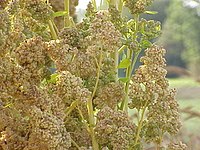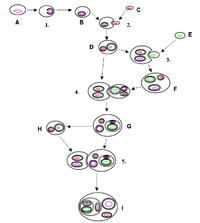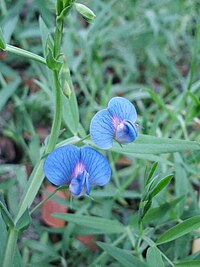
Development and physicochemical characterization of a new grass pea (Lathyrus sativus L.) miso.
Sign Up to like & getrecommendations! Published in 2020 at "Journal of the science of food and agriculture"
DOI: 10.1002/jsfa.10842
Abstract: BACKGROUND Western consumers interest in Eastern fermented foods has been growing, due to their nutritional and healthy properties. In this study, new sweet misos and salty misos were produced using grass pea (Lathyrus sativus L.)… read more here.
Keywords: misos; grass; pea lathyrus; miso ... See more keywords

Role of abscisic acid in modulating drought acclimation, agronomic characteristics, and β-N-Oxalyl-L-α, β-diaminopropionic acid (β-ODAP) accumulation in grass pea (Lathyrus sativus L.).
Sign Up to like & getrecommendations! Published in 2021 at "Journal of the science of food and agriculture"
DOI: 10.1002/jsfa.11597
Abstract: BACKGROUND β-N-oxalyl-L-α, β-diaminopropionic acid (β-ODAP) is a physiological indicator in response to drying soil. However, how abscisic acid (ABA) modulates β-ODAP accumulation and its related agronomic characteristics in drought stressed grass pea (Lathyrus sativus L.)… read more here.
Keywords: accumulation; acid; grass pea; agronomic characteristics ... See more keywords

Grass pea (Lathyrus sativus) flour: microstructure, physico-chemical properties and in vitro digestion
Sign Up to like & getrecommendations! Published in 2018 at "European Food Research and Technology"
DOI: 10.1007/s00217-018-3152-y
Abstract: Flour from grass pea, a legume that is adapted to arid conditions containing high levels of proteins, was characterized according to microstructure, some functional properties and digestibility. Microstructural results showed that grass pea starch granules… read more here.
Keywords: vitro digestion; pea; grass pea; starch ... See more keywords

A diversity of resistance sources to Fusarium oxysporum f. sp. pisi found within grass pea germplasm
Sign Up to like & getrecommendations! Published in 2021 at "Plant and Soil"
DOI: 10.1007/s11104-021-04895-z
Abstract: Grass pea is a legume species with recognized resistance to several diseases and thus important for the improvement of related major legume crops. It is infected by the soil-borne fungus Fusarium oxysporum f. sp. pisi… read more here.
Keywords: resistance; pea; fusarium oxysporum; grass pea ... See more keywords

Genome-wide identification of drought-responsive miRNAs in grass pea (Lathyrus sativus L.)
Sign Up to like & getrecommendations! Published in 2020 at "Plant Gene"
DOI: 10.1016/j.plgene.2019.100210
Abstract: Abstract The grass pea (Lathyrus sativus L.) is an attractive legume which grows traditionally in drought-stricken, rain-fed and poor fertile soils. Globally drought is a major constraint for agriculture. Regulatory mechanism such as non-coding RNA… read more here.
Keywords: drought; grass; lathyrus sativus; pea lathyrus ... See more keywords

Lathyrus sativus resistance against the existing and emerging pathogens Erysiphe pisi and Erysiphe trifolii: A case of commonalities or total discrepancy?
Sign Up to like & getrecommendations! Published in 2023 at "Phytopathology"
DOI: 10.1094/phyto-06-22-0227-fi
Abstract: Powdery mildew in Lathyrus sativus (grass pea), is commonly caused by Erysiphe pisi, the causal agent of pea powdery mildew. Erysiphe trifolii could also impose an additional threat to grass pea, as it does to… read more here.
Keywords: resistance; pea; grass pea; trifolii ... See more keywords

Graphical analysis of forage yield stability under high and low potential circumstances in 16 grass pea (Lathyrus sativus L.) genotype
Sign Up to like & getrecommendations! Published in 2023 at "Acta agriculturae Slovenica"
DOI: 10.14720/aas.2023.119.1.2227
Abstract: Introducing grass pea genotypes with wide adaptability across diverse environments is important. Dry forage yield of 16 grass pea genotypes, tested in a RCBD design with three replicates across 4 locations over 3 seasons in… read more here.
Keywords: ifla; grass pea; stability; yield ... See more keywords

Drought tolerance in some populations of grass pea (Lathyrus sativus L.)
Sign Up to like & getrecommendations! Published in 2017 at "Legume Research"
DOI: 10.18805/lr-346
Abstract: In Algeria, the genus Lathyrus is cultivated mainly for grain production (food) and also used as fodder (animal feed). Lathyrus sativus L. or grass pea has a good resistance to drought, salinity and flooding. However,… read more here.
Keywords: sativus drought; seed; grass pea; lathyrus sativus ... See more keywords

What is the Difference between the Response of Grass Pea (Lathyrus sativus L.) to Salinity and Drought Stress?—A Physiological Study
Sign Up to like & getrecommendations! Published in 2020 at "Agronomy"
DOI: 10.3390/agronomy10060833
Abstract: Understanding the mechanisms of plant tolerance to osmotic and chemical stress is fundamental to maintaining high crop productivity. Soil drought often occurs in combination with physiological drought, which causes chemical stress due to high concentrations… read more here.
Keywords: stress; salinity drought; drought; grass pea ... See more keywords

Impact of Grass Pea Sweet Miso Incorporation in Vegan Emulsions: Rheological, Nutritional and Bioactive Properties
Sign Up to like & getrecommendations! Published in 2023 at "Foods"
DOI: 10.3390/foods12071362
Abstract: Grass pea (Lathyrus sativus L.) is a pulse with historical importance in Portugal, but that was forgotten over time. Previous to this work, an innovative miso was developed to increase grass pea usage and consumption,… read more here.
Keywords: sweet miso; grass; grass pea; emulsion ... See more keywords